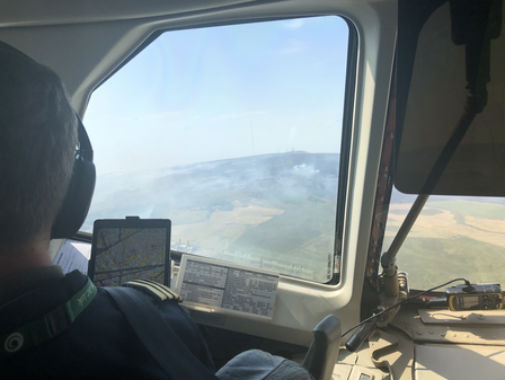Aeroplane lab samples pollution from moorland fires
Posted on 11 July 2018

The team measured and sampled the air pollution from the Winter Hill and Saddleworth fires.
Operating the UK’s specially adapted research aircraft, the team of atmospheric scientists have measured and sampled the air pollution released from the moorland fires at Winter Hill and Saddleworth.
The recent heatwave has left the UK’s peaty moorlands vulnerable to burning, contributing to global warming in the same way as burning fossil fuels. The blazes broke out on the moors in late June during hot, dry weather and have continued throughout the heatwave despite ongoing efforts from the Greater Manchester Fire and Rescue Service.
Airborne lab
Samples from the fire plumes were taken by a team of University of York researchers from the National Centre for Atmospheric Science (NCAS) on board the UK Natural Environment Research Council (NERC) and Met Office aircraft operated by FAAM (the Facility for Airborne Atmospheric Measurements).
The team has previously used the airborne laboratory, a modified BAE-146-301 aircraft, to measure methane levels from tropical fires in Africa, but are now using the same techniques to understand the UK moorland fires.
The samples are being analysed to identify gases like methane coming from the burning peat, and will also point to any other pollutants being released.
Climate change
Flight Lead, Professor James Lee, from the University's Department of Chemistry, said: “Molecule-for-molecule, methane is a much more powerful greenhouse gas than carbon dioxide. The amount of methane in the air is rising fast, but scientists do not yet know why.
"Studying methane released from peat fires will be helpful in identifying how much of the rise is from the burning of organic material such as peat and plants, and how much from other sources like gas leaks, coal mining, swamps and cows.”
“More hot dry weather due to climate change is likely to lead to more moorland fires in the UK and worldwide, so it is important that we begin to understand the effects on global greenhouse gas levels and air pollution problems.
“The measurements taken on board the research aircraft will also give us a much better insight into the significant air pollution caused by these fires, and allow us to investigate the potential effect of future fires on the quality of the air people are breathing downwind from fires."
Satellite images
In many parts of the world, burning forests, peatlands and agricultural waste create extensive and long-lasting air pollution events that have significant impacts not only on public health, but also on transport systems and industrial productivity.
The National Centre for Earth Observation have also released satellite images of the fires over the past two weeks, which can be viewed here.
The work can also been viewed on BBC news here.
Explore more news

Breakthrough in blood test for Alzheimer’s by University of York researchers
Thursday 9 October 2025

Pharmacists could save the NHS billions of pounds with medicines checks, according to analysis by University of York
Monday 6 October 2025

University of York spin-out company receives funding boost
Monday 6 October 2025

Societal inequality linked to structural brain changes in children
Tuesday 30 September 2025

Cancer study to address ‘neglect’ of Gypsy, Traveller and Roma community
Tuesday 30 September 2025
Media enquiries
About this research
The study, led by Professor James Lee, Department of Chemistry, is part of Project MOYA – the global methane budget, which is a project funded by NERC.
